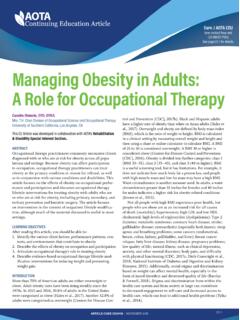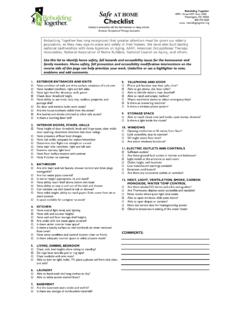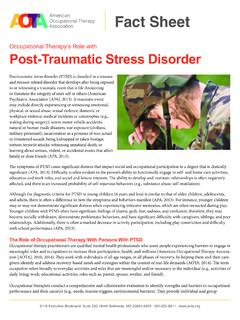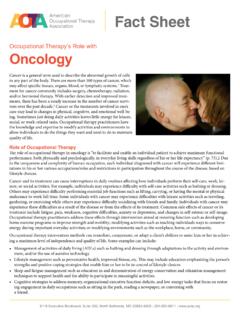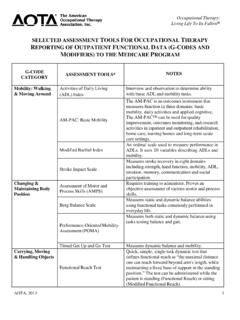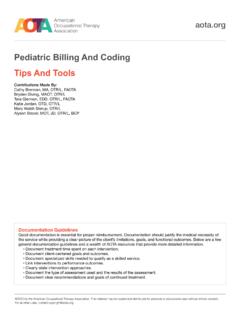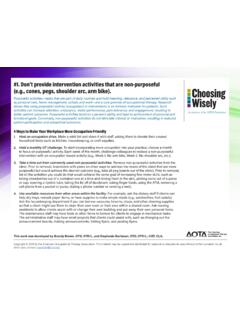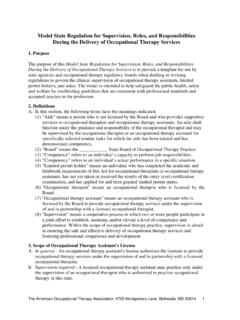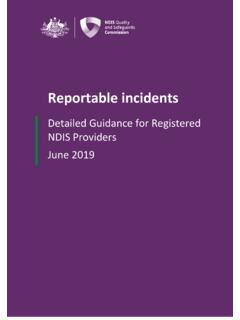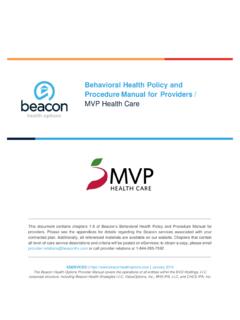Transcription of Understanding and Applying Trauma-Informed …
1 Continuing Education Article Earn .1 AOTA CEU (one contact hour and NBCOT PDU). See page CE-8 for details. Earn .1 AOTA CEU. (one contact hour and NBCOT PDU). See page CE-8 for details. Understanding and Applying Trauma-Informed Approaches Across Occupational Therapy Settings Claudette Fette, PhD, OTR, CRC INTRODUCTION TO trauma AND Trauma-Informed APPROACHES. Texas Woman's University, Denton, TX Formal recognition of trauma and its associated implications can be traced back to the American Civil War, when the effects of Carol Lambdin-Pattavina, OTD, OTR/L war on soldiers was described by terms such as soldier's heart and University of New England, Portland, ME nostalgia. Terms such as shell shock and battle fatigue were used to describe a similar phenomenon during World War I and World Lindy L. Weaver, PhD, MOT, OTR/L War II. The term posttraumatic stress took hold after the Vietnam The Ohio State University, Columbus, OH War, when interest in developing more targeted interventions for returning soldiers burgeoned.
2 The third edition of the Diagnostic This CE Article was developed in collaboration with AOTA's Mental Health and Statistical Manual for Mental Disorders (DSM-III) was released Special Interest Section. in 1980 and, for the first time, trauma was officially recognized as a significant event or series of events that could potentially have ABSTRACT long-standing implications for occupational functioning (Sub- trauma and adverse childhood experiences can have lifelong stance Abuse and Mental Health services Administration [SAM- effects on emotional, behavioral, and physical health. Health HSA], 2014). Since that time, definitions of trauma and ways to providers, along with state and federal policy makers, are calling care for individuals who have experienced it have continued to for increasing Trauma-Informed care and Trauma-Informed evolve. approaches across health, social service, and education sec- Currently, trauma is defined as singular or cumulative tors.
3 Occupational therapy practitioners are likely to work with experiences that result in adverse effects on functioning and individuals with a history of trauma across many settings, and mental, physical, emotional, or spiritual well-being (SAMHSA, it is imperative to have a working knowledge of ways to support 2018). Examples of trauma include exposure to violence, nat- these individuals. This article outlines basic principles related ural disasters, bullying, displacement, food insecurity, abuse, to trauma , Trauma-Informed approaches, and research that may neglect, sexual assault, terrorism, motor vehicle accidents, and assist practitioners in Understanding how Trauma-Informed life-threatening military incidences. The original Centers for approaches align with core tenets of occupational therapy and Disease Control and Prevention (CDC) Kaiser Permanente how to facilitate best care for those they serve across all settings Adverse Childhood Experiences (ACEs) Study was the first to ask and environments.
4 A large number of people (17,000) about their history of traumatic experiences in childhood, and it found that childhood trauma is LEARNING OBJECTIVES common (CDC, ). Two thirds of adults reported experiencing After reading this article, you should be able to: least one ACE, and 1 in 5 reported three or more (Pardee et al., 1. Define basic principles of trauma and Trauma-Informed 2017). approaches Because the original ACEs study was a retrospective survey of 2. Identify research-based outcomes of Trauma-Informed adults, the National Survey of Children's Exposure to Violence approaches across practice settings was conducted in 2008 to collect data during childhood. Fin- 3. Identify application of Trauma-Informed approaches in occupa- kelhor and colleagues (2013) highlighted the cumulative harm tional therapy experienced when children are exposed to multiple forms of ARTICLE CODE CEA0519 | MAY 2019 CE-1.
5 CE-1. CE Article, exam, and certificate Continuing Education Article are also available ONLINE. Register at or Earn .1 AOTA CEU (one contact hour and NBCOT PDU). See page CE-8 for details. call toll-free 877-404-AOTA (2682). childhood victimization. They conducted a regression analysis TIAS AND THE PUBLIC HEALTH MODEL. and added ACE items based on the 2008 survey, including peer Researchers have called for all health care providers and staff victimization, property victimization, parents always arguing, working with children, youth, and adults to apply TIAs and inter- having no good friends, having someone close with a bad illness ventions (Perfect et al., 2016; Soleimanpour et al., 2017). Given or accident, low socioeconomic status, and exposure to commu- the long-term effects of adverse experiences in childhood, it is nity violence. particularly important that all disciplines working in health care The Office of Juvenile Justice and Delinquency Prevention assess trauma ; address safety in schools and the community; build and the CDC conducted a national telephone survey of 3,392 strengths and resilience; and provide opportunities for educa- school-aged children aged 5 to 17 years old regarding victim- tional, economic, and social successes (Shonkoff et al.)
6 , 2012). ization and violence exposure at school, and 74% reported Because trauma is widespread, a public health model is useful exposure to some form of victimization (Finkelhor et al., 2016; in conceptualizing TIAs at various levels and across different Perfect et al., 2016). Finkelhor and colleagues (2016) stated practice settings. A public health model divides care and health that 48% of those victimized reported at least one incident initiatives into three tiers: universal, targeted, and intensive. In at school. Furthermore, victimization at school increased the the public health framework, universal (Tier 1) services are geared likelihood that children would also be victimized elsewhere. toward universal promotion and prevention among large groups Children with disabilities reported higher rates of assault and of people. Targeted (Tier 2) services are directed at individuals bullying.
7 Whose experiences place them at risk for developing mental, trauma contributes to mental health and functional difficul- emotional, and behavioral difficulties. Last, intensive (Tier 3). ties. Individuals with multiple ACEs are more likely to engage in services focus on intensive interventions for individuals with health risk behaviors and are more likely to be obese, and have identified disorders that notably affect function and participation. higher rates of heart disease, stroke, liver disease, lung cancer, A public health model seeks to efficiently allocate resources chronic obstructive pulmonary disease, and autoimmune disor- by effectively addressing as much as possible at the lowest level ders than the general population (Oral et al., 2016). of care, beginning with Trauma-Informed universal precau- People with posttraumatic stress disorder (PTSD) may also tions applied at a whole population level.
8 At a universal level, present with disassociation and increased autonomic reactivity occupational therapy practitioners can use person-centered care and/or emotional under engagement, which causes difficulty practices, such as telling clients what is going to happen, asking in relationships. Oral and colleagues (2016) also reported a about their concerns, giving as much control as possible, and relationship between the number of ACEs and learning and asking what can be done to make them more comfortable (Raja behavioral problems in children and adolescents, and in somatic et al., 2015). All health care providers need to create safe envi- disorders, hallucinations, anxiety and obsessive compulsive ronments, recognize common symptoms of traumatic stress, disorders, depression, and suicide attempts in adults. Although and shift their responses to better support individuals who are Trauma-Informed approaches (TIAs) had their initial develop- in distress.
9 Ment and implementation in mental health settings, the current Next, targeted supports are provided to populations who are Understanding of the effect that trauma has on all body systems, at increased risk for behavioral and mental health difficulties, in addition to the notion that the vast majority of people have such as those with disabilities, physical injuries, and chronic potentially experienced trauma , have made TIAs necessary best life stressors. Bassuk and colleagues (2017) stated that within practice in all settings. systems serving high-risk, low-income populations, such as people involved in child welfare and/or homelessness, trau- SAMHSA (2018) states that a Trauma-Informed program, matic stress may be nearly universal. They proposed that trau- organization, or system: ma- informed care (TIC) be implemented in health care systems 1. Realizes the widespread effect of trauma and understands serving these populations and recommended the following potential paths for recovery guidelines: 2.
10 Recognizes the signs and symptoms of trauma in clients, 1. Establish and disseminate a person-centered standard of families, staff, and others involved with the system care. 3. Responds by fully integrating knowledge about trauma into 2. Establish collaborative healing relationships between the policies, procedures, and practices provider and the service user. 4. Seeks to actively resist re-traumatization 3. Establish SAMHSA's six TIC principles as a foundation. 4. Respect all forms of diversity. SAMHSA (2018) put forth six core Trauma-Informed principles: 5. Understand the effects of trauma , mental health, and sub- 1. Safety stance abuse conditions. 2. Trustworthiness and transparency 6. Promote belief that recovery is possible for all. 3. Peer support and mutual self-help 7. Ensure person-centered care is individualized and transpar- 4. Collaboration and mutuality ent, and be accountable.
